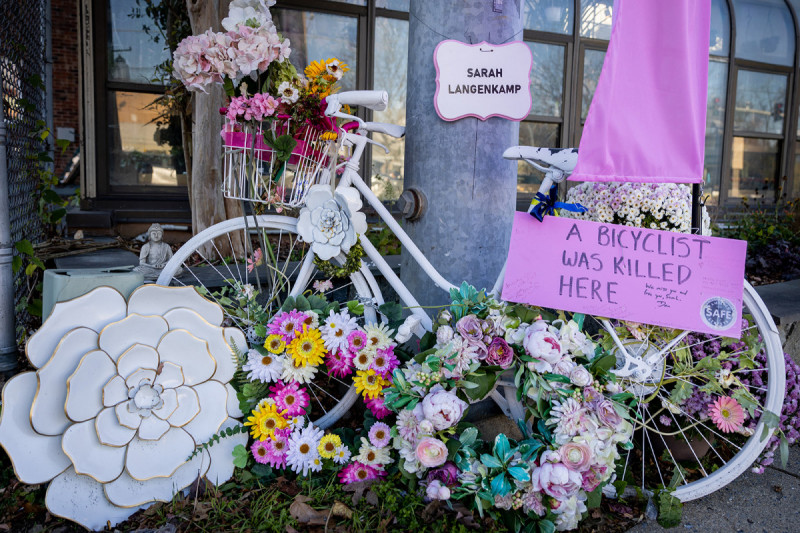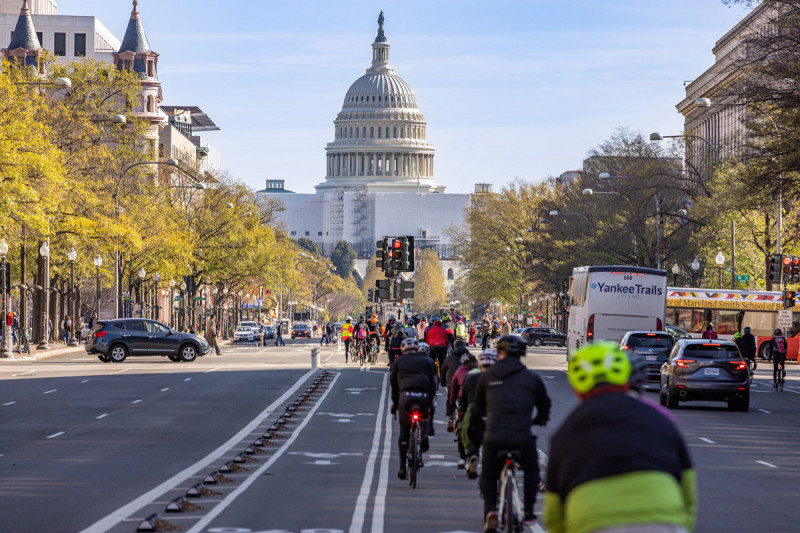Editor's note: This article originally appeared on Greater Greater Washington and is republished with permission. Read Streetsblog's earlier coverage about the death of Sarah Langenkamp's and her family's efforts to make roads safer in her memory here and here.
With midterm elections fading from view and the season of family gatherings in full swing, the attention of millions of Americans is now turning towards home, hearth, and holiday parties.
But not for me and my sons, who cannot stop thinking about the afternoon in late August when a man driving a flatbed semi made a sudden right turn, crushing and killing my wife and their mom, Sarah Debbink Langenkamp, who was riding her bike in Bethesda, Maryland.
And it won’t be festive for the family members of more than 40,000 others who are killed on American roads, sidewalks, and bikeways this year – reflecting a 16-year high. For all of us, this season of celebration will be overshadowed by our indescribable loss.
Sarah and I, US diplomats, had only recently arrived back in the United States after being evacuated from Ukraine. Since her death, I have been trying to understand how she could have died here, near our nation’s capitol, where we had returned — ironically enough, for our safety.

Fatal flaws in the system
While some people might say her death was a rare and even freakish accident, what I have since learned is far different. Sarah actually fell victim to a worrying national trend: As cars and trucks have become bigger, faster, heavier, and safer for those inside them, they are becoming more dangerous for those outside them, particularly people walking and biking.
The statistics bear this out: Last year was the most deadly in four decades for people walking in America, and 2020 (the last year for which data is available) was the most deadly for people bicycling since 1994 (the first year for which data is available).
This worsening trend is taking place even as our peer nations make their own transportation systems safer and reduce fatalities.
The United States, for instance, stands in a dismal 47th place in terms of pedestrian fatalities in a list of 54 industrialized countries studied by the World Health Organization (WHO). Our death rate among pedestrians in car/truck crashes is more than 600 percent higher than the safest countries, like Iceland, Singapore and Norway. Our fatality rate is twice that of Canada.
As a US diplomat used to boasting about America’s can-do attitude all over the world, traffic death statistics not only hurt. They are enraging — because we know the solution to these problems.
We know bike lanes can be made safer with curbs or even plastic stanchions that separate bikers from car traffic.
We know that trucks with blind spot sensors, pedestrian/bicycle detection systems, automatic emergency braking, or underride guards (to prevent people from being crushed underneath trucks, as Sarah was) can save lives at low cost.
And we know that behind-the-wheel training for first-time drivers of Class A commercial vehicles —who aren't currently required to have such training before they take control of these deadly machines — is so important for public safety.
Why have we not implemented these and other proven safety measures that are required in many other nations?

Riding for our lives
To be fair, there is some encouraging movement, as the Biden administration and Secretary of Transportation Pete Buttigieg created the first-ever National Roadway Safety Strategy to work toward making streets safe for everyone.
That is a good start — but not nearly enough. That is why I organized the Ride for Your Life on November 19, where riders retraced Sarah’s route on the day she died. We then joined walkers on Pennsylvania Avenue and headed to the US Capitol to hear from those of us who have lost loved ones due to unsafe traffic conditions and Congressman Jamie Raskin. It was the first event of its kind, pressing Congress to expand safety funding and asking the Department of Transportation to introduce long-overdue truck safety measures.
We weren’t alone. Our event coincided with others in more than 60 communities across the nation commemorating World Day of Remembrance for Road Traffic Victims on November 20, organized in part by Families for Safe Streets — an organization of crash victim family members. It’s a group I have, despairingly, just joined.

A reckoning for our transportation system
We have a reasonable demand: The killing must stop.
In the 1970s in Amsterdam, mothers fed up with pedestrian and cyclist deaths began the “Stop Killing Children” movement, helping create the bike-friendly country that the Netherlands is today.
While the United States may not become the Netherlands overnight, we can certainly turn around our deadly trends. Sarah, other victims, and so many families mourning this holiday season deserve at least as much.






